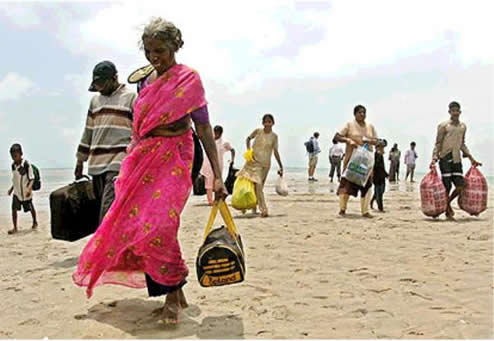 I spent yesterday afternoon at the launch of the new Foresight report on Migration and Global Environmental Change, a study commissioned and led by the government’s chief scientific adviser, Sir John Beddington. Drawing on the best available science and analysis from other disciplines, the project aimed to develop a picture of how international and internal migration patterns might be affected by global environmental changes between now and 2060, and the implications of these developments for policymakers.
I spent yesterday afternoon at the launch of the new Foresight report on Migration and Global Environmental Change, a study commissioned and led by the government’s chief scientific adviser, Sir John Beddington. Drawing on the best available science and analysis from other disciplines, the project aimed to develop a picture of how international and internal migration patterns might be affected by global environmental changes between now and 2060, and the implications of these developments for policymakers.
It is a substantial report, and looks like important reading for those working on migration, climate change and many other related issues. It is also full of crunchy data and pretty charts, which always helps. Some of the top-line conclusions are unsurprising. It states that environmental change has a clear impact on migration through its influence on the web of political, economic and social drivers that lead people to move, and that this impact will only increase in the future as the world becomes more populated and as natural hazards proliferate. It also argues that the complex interaction of drivers will lead to different migration outcomes, and that well-planned and coordinated policy responses will reduce the risks of humanitarian emergencies and displacement. So far, so predictable.
However, some of its findings and recommendations are more counterintuitive, and should be studied carefully by policymakers. Three in particular jumped out at me.
1. People will increasingly migrate towards environmentally vulnerable areas.
Ask about environmental change and migration, and most people will think of events that that displace large numbers of people in a short period of time: disasters like Hurricane Katrina, the 2004 Asian tsunami and Cyclone Nargis, or droughts and famines in sub-Saharan Africa. The image is of people running away from environmental hazards – a vast stream of ‘climate refugees’. Yet as individuals and households try and carve out space in a rapidly changing global economy, migration will increasingly take place in the other direction, towards urban areas where there are more opportunities to diversify livelihoods but also where the risks of environmental hazards are greater.
This will be particularly true in large cities in low-income countries. For example, the research for this report indicates that the number of people living in floodplains of urban areas in East Asia may rise from 18 million in 2000 to anywhere between 45 and 67 million by 2060. This has huge implications for policymakers and urban planners, who will need to design cities that are capable of absorbing many more people in a sustainable way and that are much more resilient to environmental change than is currently the case.
2. Environmental change is equally like to make migration less possible as more probable.
Migration is an expensive business, requiring considerable financial capital. Contrary to popular opinion, it is not usually the poorest of the poor who migrate, but instead those who have acquired some economic assets. However, as the Foresight report points out, environmental changes (such as drought and flooding) may destroy or remove the very capital that enables people to migrate, leaving large numbers ‘trapped’ in areas that are particularly vulnerable. This comes with substantial risks, since it may encourage people to migrate in more irregular and unsafe ways to seek new sources of income.
3. Preventing or constraining migration is not a no-risk option.
While the debate on migration in many countries often generates recommendations about how to limit people’s ability to move, the evidence gathered for this report supports the case of those who argue that putting severe limits on migration can have a harmful impact on both the development of the individual in question as well as that of both sending and receiving countries (full disclosure: IPPR has broadly subscribed to this view in its work on both UK migration policies as well as international migration and development).
The Foresight report suggests that migration should be regarded as a broadly positive process that can give people access to new employment opportunities that increase their resilience to shocks. It points out that in 2009, remittances sent by international migrants to low income countries totalled around US$307 billion (nearly triple the amount of development aid that was disbursed in the same year). Remittances are not a silver bullet, and will not prevent migration driven by development needs or environmental changes. But by facilitating the freer movement of people both internally and internationally and improving their capacity to send remittances home, policymakers may enable more households to remain in situ than would otherwise be the case.
The work of the Foresight team has provided plenty of food for thought, and some good ideas that should be mainstreamed into planning on migration and environmental change. Let’s hope that policymakers are listening.



